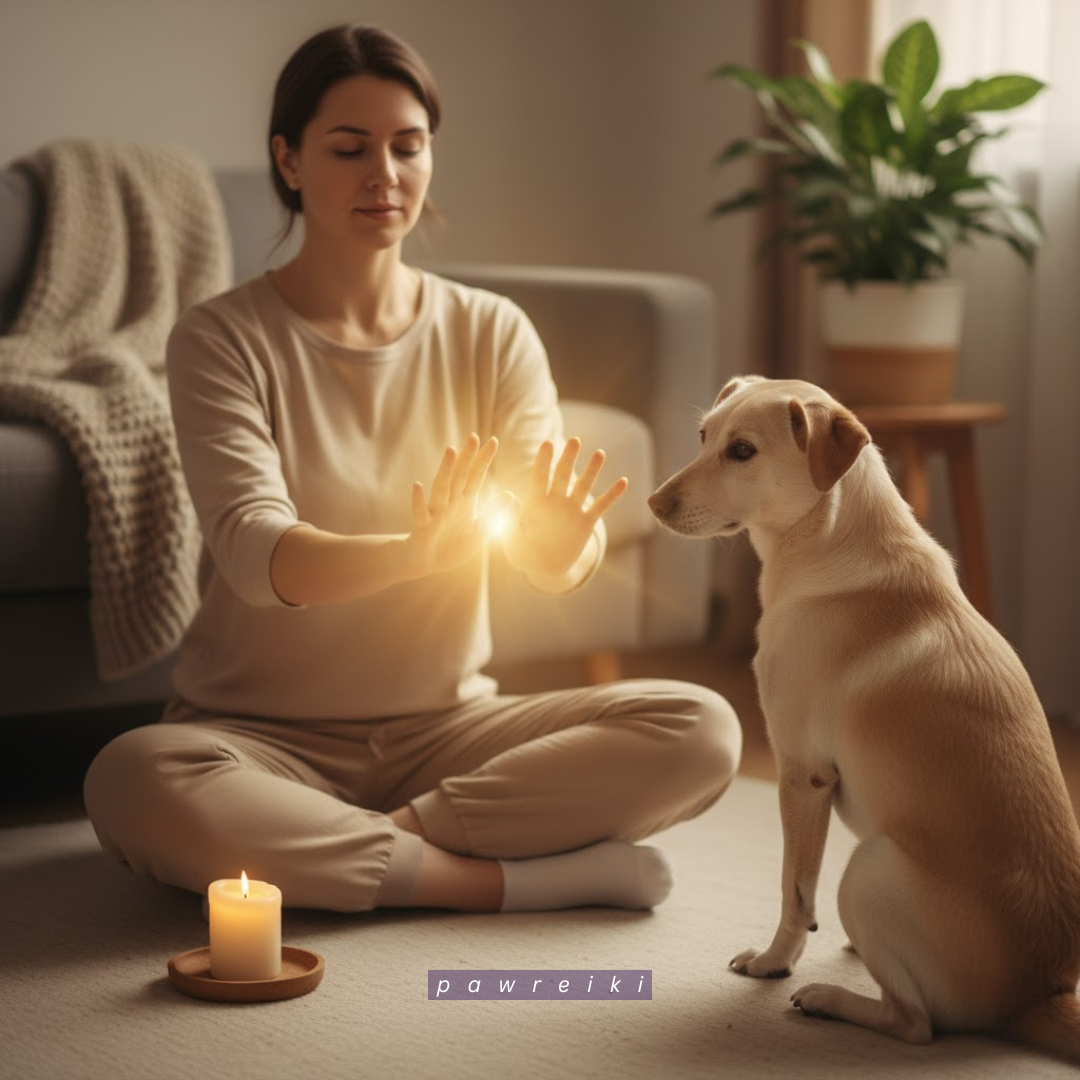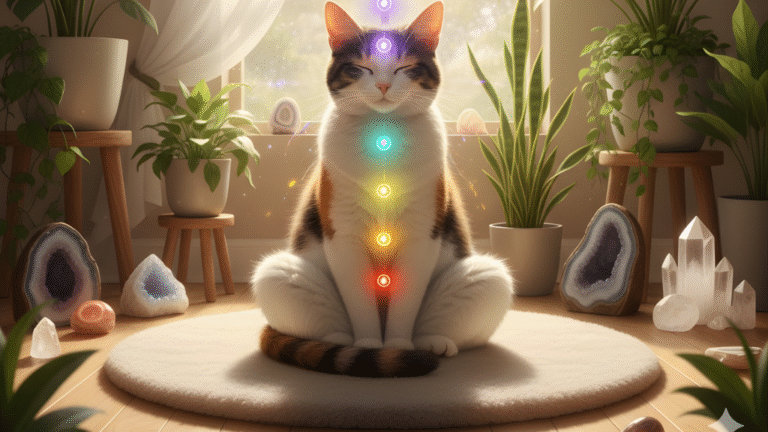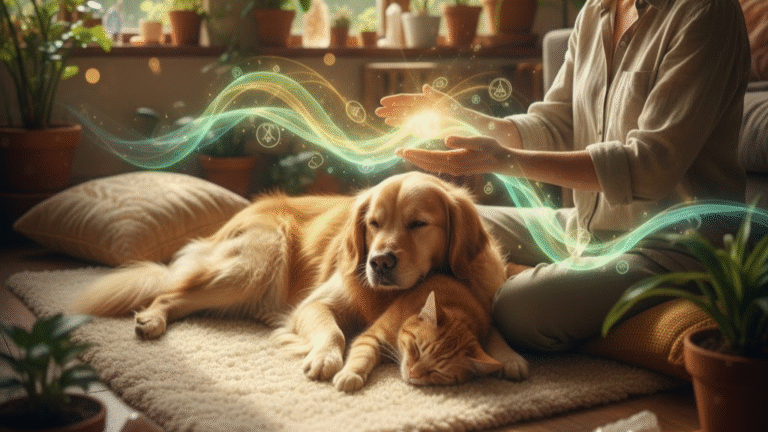Reiki For Pets: A Gentle Guide To Energy Healing At Home
Reiki for Pets offers a gentle, non-invasive way to support your animal’s emotional and physical well-being. This ancient energy healing practice helps reduce stress, calm anxiety, and promote faster recovery from illness or trauma.
Whether you have a cat, dog, or other companion, Reiki for Pets can strengthen your bond while restoring balance and harmony. It’s simple, soothing, and something you can easily learn to do at home.
Signs Your Pet May Need Reiki
1. Unusual Anxiety Or Restlessness
If your pet suddenly becomes anxious, pacing, or hiding, it may indicate an energetic imbalance. Reiki can calm nervous energy, helping them feel grounded and safe.
Animals often pick up on household stress, so gentle Reiki sessions restore harmony and emotional balance, easing tension from environmental changes, travel, or even your own stress.
2. Unexplained Physical Discomfort
When your pet seems sore, stiff, or uncomfortable without a clear medical cause, Reiki may help. It facilitates better energy flow and relaxation, which enhances the body's natural healing process.
Many pets respond with sighs, stretching, or deep sleep as discomfort eases. It’s especially beneficial for aging animals with mild aches or fatigue.
3. Behavioural Changes Or Withdrawal
A usually social pet becoming distant, irritable, or unusually quiet might signal emotional or energetic distress. Reiki helps release blocked emotions and restores harmony.
With consistent sessions, pets often regain their friendly nature and emotional balance. It’s beneficial for animals that have experienced trauma, grief, or sudden environmental shifts.
4. Slow Recovery After Illness Or Surgery
If healing seems delayed after treatment or surgery, Reiki can gently support recovery. It boosts energy circulation, reduces stress, and complements veterinary care by promoting relaxation.
Many pets show renewed vitality after consistent sessions, eating and moving more comfortably. Reiki doesn’t replace medicine—it helps the body respond better to it.
5. Fear Of Touch Or Human Contact
Pets that flinch, avoid touch, or fear human approach often hold emotional blockages. Reiki provides a safe, non-invasive way to rebuild trust.
You can begin from a distance, letting energy reach them without pressure. Over time, many animals soften, approaching you willingly as they sense compassion and safety in your presence.

6. Digestive Issues Or Appetite Changes
Sudden appetite loss or digestive upset without a medical cause can point to stress-related imbalances. Reiki soothes the nervous system and calms emotional energy, which can ease digestion naturally.
Many pet owners notice improved appetite and more regular eating patterns after several gentle, focused Reiki sessions.
7. Signs Of Grief Or Loss
Animals grieve deeply after losing a companion, human, or home. They may appear withdrawn, lethargic, or depressed. Reiki helps comfort their heart energy, offering peace and emotional release.
With consistent practice, pets often regain interest in play, affection, and daily life as emotional heaviness gradually lifts.
8. Hyperactivity Or Overexcitement
If your pet can’t seem to calm down or constantly seeks stimulation, Reiki can balance their energy. By soothing overactive chakras, it helps them relax naturally without suppressing their playful spirit.
After sessions, many pets show calmer behaviour, better focus, and deeper sleep, restoring overall emotional equilibrium.
9. Aging Or End-Of-Life Transitions
Senior pets often face fatigue, pain, or confusion during their final years. Reiki provides gentle comfort, easing physical tension and emotional distress.
It helps them relax, sleep peacefully, and transition with dignity. Many owners find Reiki comforting, too—it strengthens the bond and brings mutual calm in difficult moments.
10. Overly Clingy Or Dependent Behaviour
A pet that suddenly becomes overly attached or anxious when you leave may be absorbing your stress. Reiki can help rebalance both your energies, easing separation anxiety.
As your pet feels emotionally grounded again, independence and confidence naturally return. Balanced energy leads to a calmer, happier connection for both of you.

Step-By-Step Guide To Energy Healing At Home
Step 1: Centre Yourself
Before beginning Reiki, you must first ground your own energy. Close your eyes, take a comfortable seat, and slowly breathe through your nose.
Use your mouth to release any tension. Imagine being anchored by roots that reach deep into the ground from your feet. Then picture warm, golden light filling your chest and flowing through your arms into your palms.
This grounding ensures you transmit pure, calm energy to your pet. Animals instantly pick up on human emotions — your peace becomes their comfort.
Common Reactions
Your pet may stop what they’re doing, stretch, glance your way, or approach quietly. They can sense the shift in your energy field.
Calming Process
Continue breathing rhythmically, maintaining stillness. This phase prepares both you and your pet for safe, balanced, and heart-centred healing.
Step 2: Ask For Permission
Animals communicate energetically, even without words. Before you begin, mentally ask, “Would you like to receive Reiki today?”
Then pause and observe. Their response will be subtle but clear. If your pet walks toward you, relaxes, or lies down, that’s permission granted.
If they walk away, turn their head, or show unease, respect it. Forcing Reiki disrupts trust. The practice should always be mutual, never imposed.
Common Reactions
Pets who agree may come closer, make eye contact, or let out a gentle sigh. Hesitant ones may yawn, move slightly away, or simply observe.
Calming Process
If they seem unsure, stay quiet and grounded. Sometimes, your stillness alone creates enough peace for them to return and accept the energy later willingly.
Step 3: Begin From A Distance
Start with your hands six to twelve inches away from your pet. Picture healing light gently streaming from your palms toward them. Distance Reiki lets sensitive or rescued animals feel secure without direct contact.
Keep your breathing slow and your mind centred on love and balance. The energy naturally flows to where it’s needed most, guided by your intention.
Common Reactions
Pets often relax their ears, lower their head, or shift into a comfortable position. Some close their eyes or begin breathing more deeply.
Calming Process
If your pet is nervous, softly hum or speak in a soothing voice. Gentle verbal vibrations, combined with Reiki energy, help calm the nervous system and invite a sense of safety and peace.
Step 4: Gentle Hand Placements
Once your pet is comfortable, slowly place your hands on or just above their body. Focus on common energy centers — the crown (top of the head), heart (chest), solar plexus (stomach), and base (hips).
Keep your touch soft and consistent. Let intuition guide how long you stay in each spot. Reiki moves where it’s needed, whether physical or emotional.
Common Reactions
You may feel warmth or pulsing under your hands as their body absorbs energy. Pets often sigh, stretch, or even fall asleep. Tiny muscle twitches show blocked energy release.
Calming Process
Synchronize your breathing with theirs. This shared rhythm strengthens the energetic connection and helps both of you slip into a deeper state of calm and mutual harmony.

Step 5: Observe And Adjust
Reiki is an intuitive exchange, not a fixed routine. Stay aware of your pet’s body language. If they shift or move, follow their guidance — that’s where energy is most needed.
If they step away, respect their space. Energy continues flowing even at a distance. Avoid overthinking. Let each moment guide your hands naturally.
Common Reactions
Deep breathing, tail wagging, or quiet blinking show acceptance. Some pets may roll onto their side, exposing the belly — a powerful sign of trust.
Calming Process
If energy feels intense or overwhelming, pull your hands back slightly. Whisper reassurance or simply radiate calmness. Reiki flows best through gentle presence, not effort, creating a soothing balance between action and surrender.
Step 6: Close The Session
You’ll intuitively feel when the session is complete — often when your pet moves away, yawns, or falls into peaceful rest. Slowly lift your hands and place them over your heart.
Thank your pet silently for accepting healing and thank the Reiki energy for flowing freely. Say in your mind, “This session is complete.” Let gratitude seal the energy exchange.
Common Reactions
Pets may shake off, drink water, or curl up in sleep afterward. These are grounding behaviours that help them integrate a new balance.
Calming Process
Stay beside them quietly for a few minutes. Stroke them gently if they invite touch. Your presence helps anchor the calm energy into their body and environment.
Step 7: Post-Session Integration
After Reiki, your pet’s body continues to process energy adjustments. Give them time to rest. Offer fresh water and a peaceful environment.
Avoid loud noises or stimulation for a few hours. Reiki can trigger emotional or physical release — yawning, deep breathing, or long naps are common.
Common Reactions
Some pets sleep deeply, while others become affectionate or playful. You might notice softer eyes or looser body language.
Calming Process
Keep your energy soft and grounded. Avoid rushing them. Play quiet music or sit nearby in silence. Integration time allows the healing to anchor, turning energy balance into lasting calm and physical renewal.
Step 8: Reflect And Recharge Yourself
After giving Reiki, take care of your own energy. Sit comfortably, close your eyes, and place your hands over your heart. Reflect on the session — what did you feel, see, or sense?
Did your pet’s breathing slow? Did warmth or tingling arise in your palms? Acknowledge it all without judgment. Reiki heals both giver and receiver.
Common Reactions
You might feel sleepy, emotional, or deeply peaceful. Pets may remain close, sensing your relaxed aura.
Calming Process
Drink water and visualize any remaining energy grounding into the earth. This step resets your body’s balance and keeps your energy field clear for future sessions with your furry friend.

Step 9: Maintain A Reiki Routine
Consistency strengthens results. Practicing Reiki regularly — even for a few minutes daily — helps pets stay balanced and emotionally secure.
Over time, they’ll begin to recognize when healing energy flows and may eagerly approach you. The trust and routine deepen your bond and keep their energy aligned.
Common Reactions
Many pets start showing signs of anticipation — lying near your Reiki space, turning their head toward your hands, or softly meowing or wagging their tail.
Calming Process
End each session with gentle gratitude. Smile, whisper loving words, and affirm your shared peace. This emotional closing completes the energy cycle, leaving your pet calm, loved, and connected.
Want to Share Your Love for Pet Reiki?
Discover how rewarding it can be to bring healing energy and compassion to pets — and to share that passion online with others.
🌟 Please read: How to Make Money Within the Pet Reiki NicheMistakes To Avoid
Reiki for pets offers a gentle, natural way to restore balance and calm. It strengthens your bond, eases stress, and supports emotional and physical healing through a peaceful, loving energy connection.
1. Forcing Physical Contact
Never hold or restrain your pet during Reiki. Animals must feel free to move away when they need space. Forcing touch disrupts energy flow and breaks trust.
Always let them guide the session — even distant energy works beautifully. When pets feel safe, they’ll naturally approach or relax near you, signalling readiness to receive healing.
2. Expecting Instant Results
Reiki isn’t a quick fix. Some pets respond immediately, while others need multiple sessions to open up and trust the energy. Healing unfolds in layers — physical, emotional, and energetic.
Be patient and consistent. Small changes, like deeper sleep or softer behaviour, are signs of progress. Over time, the calm and balance deepen naturally.
3. Overlooking Veterinary Care
Reiki complements but doesn’t replace professional treatment. If your pet is sick, always consult a veterinarian. Use Reiki to reduce stress, support healing, and comfort your pet alongside medical care.
This partnership works beautifully — vets handle the physical, while Reiki nurtures emotional and energetic recovery. Always combine both for the best outcome.
4. Practicing In A Distracting Environment
Reiki requires peace and focus. Avoid loud noises, bright lights, or high traffic areas. Choose a quiet, cozy spot where your pet feels safe.
Turn off devices, dim the lights, and keep the atmosphere serene. When the space feels calm, energy flows more easily — your pet can relax deeply and fully receive healing.
5. Ignoring Subtle Cues
Pets communicate with body language. If yours yawns, sighs, or walks away, that’s feedback — not rejection. Don’t chase or insist they stay. Instead, pause and send energy from a distance.
Respect their boundaries. The more you honour comfort level, the faster trust builds, and sessions become naturally longer and more effective.
6. Setting Rigid Expectations
Every pet is different. Some love long sessions; others only tolerate brief moments. Don’t measure success by duration or visible reaction. Healing happens quietly and often unseen.
Trust that your loving intention reaches them exactly as needed. Reiki works in subtle, beautiful ways — stay open and grateful for each slight shift.

FAQs
Q1. Can Reiki Help Aggressive Or Anxious Pets?
Yes, Reiki is beneficial for emotional imbalances. Start with short, hands-off sessions — sit near your pet and send calm, grounding energy through intention.
Over time, their defensive or anxious behaviours may soften. Many owners notice reduced aggression, better sleep, and increased trust. The key is consistency and patience — energy healing takes time to build trust.
Q2. How Often Should I Practice Reiki On My Pet?
It depends on your pet’s needs. For stress or mild anxiety, a few sessions per week may be enough. For chronic issues or trauma recovery, daily or every-other-day sessions help.
Let your pet guide you — if they walk away, respect that boundary. Over time, they’ll choose to stay longer as they feel safe and soothed by your energy.
Q3. How Long Should Each Reiki Session Last?
Sessions usually last between 10 and 30 minutes. Some pets only accept energy for a few minutes at first, while others may enjoy a full half-hour.
Follow their cues — yawning, stretching, or lying down deeply are good signs they’re receiving energy. If they seem restless, stop and try again later. Short, consistent sessions work better than long, forced ones.
Q4. What If My Pet Moves Away During Reiki?
That’s normal! Animals often sense shifts in energy and may move to adjust their comfort. If they walk away, let them. Continue sending energy from a distance using your intention.
Sometimes, they just need space before coming back. You can also gently call them or sit quietly nearby. Reiki works just as effectively from across the room.
Q5. Can Reiki Replace Veterinary Care?
No, Reiki complements but never replaces medical care. It helps reduce stress, ease discomfort, and promote natural healing, but it doesn’t treat disease directly.
Always consult your veterinarian for diagnosis or treatment. Reiki works beautifully alongside vet care — it supports emotional and energetic recovery, making medical treatments more effective.
Q6. What Signs Show Reiki Is Working For My Pet?
You may notice your pet sigh, yawn, stretch, or fall into a deep sleep. Others may lick their paws or blink slowly — these are relaxation cues.
Over time, pets often show improved mood, appetite, or mobility. Some might seek out your hands or nuzzle during sessions — that’s their way of saying, “I like this, keep going!”
Conclusion
Reiki for Pets is more than a healing method—it’s a shared moment of peace and connection. By practicing regularly, you can help your furry friend feel calmer, healthier, and more loved.
Each session deepens your understanding of their needs and strengthens your emotional bond. Start small, stay consistent, and let Reiki for Pets guide both you and your companion toward balance, comfort, and lasting well-being.
I trust you enjoyed this article on Reiki For Pets: A Gentle Guide To Energy Healing At Home. Please stay tuned for more Reiki insights, pet wellness tips, and holistic lifestyle ideas.
Take care!
— JeannetteZ
💬 Your Opinion Is Important To Me
Do you have thoughts, ideas, or questions? I’d love to hear from you. Please leave your comments below or email me directly at Jeannette@pawreiki.com.
📚 More PawReiki Reads — Discover Energy Healing & Holistic Pet Wellness
💜 My #1 Recommendation for Online Success
Reiki has brought so much peace and purpose to my life, and sharing it online has been a true blessing. If you’ve ever dreamed of creating a gentle income stream around your love for animals and holistic healing, this platform gives you all the tools, training, and community support you need — no tech experience required.
🌟 See How Reiki Lovers Build Online Income — Try WA FreeNo credit card required · Free starter training included
Disclosure
This post may contain affiliate links. As an Amazon Associate and participant in other affiliate programs, I earn from qualifying purchases at no extra cost to you. Please read my full affiliate disclosure.







